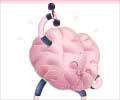Here is another feather in the crown of physical exercisers. A new study in older adults finds that regular exercise may speed up the wound-healing process by as much as 25 percent.
The faster that a wound heals, the less chance it will become infected.The results appear in a recent issue of the Journal of Gerontology: Medical Sciences.
This is the first time such an enhancement associated with exercise is being documented, according to Charles Emery, a professor of psychology and the lead author of the Ohio State University study.
The study included 28 healthy older adults ranging in age from 55 to 77 (average age 61). The participants hadn't exercised regularly for at least six months prior to the study. For the research, about half (13) of them exercised three times a week for three months. The other 15 participants served as controls and were asked not to change their physical activity habits during the study period.
A month after they started exercising, each subject received a small puncture wound on the back of the upper arm. A month of exercise before the wound procedure gave the bodies of adults in the exercise group enough time to adapt to a regular exercise program.
The wounds were about 1/8-inch across and deep. The researchers photographed the wounds three times a week until the wounds were no longer visible (about six to seven weeks).
Advertisement
Assessments of exercise endurance and stress were made on each participant at the beginning and end of the study. The exercise endurance test, completed on a treadmill, measured each subject's aerobic fitness level by measuring how much oxygen he or she consumed while working out.
Advertisement
Lastly, each subject completed a questionnaire called the Perceived Stress Scale. This scale let the researchers determine how stressful the respondents perceived their lives to be.
At the end of the study, researchers found that skin wounds healed an average of 10 days faster in the people who exercised (29 days in the exercise group vs. 39 days in the non-exercise group.)
Not surprisingly, exercise endurance increased in the group that worked out, but remained the same in the non-exercise group.
The researchers were somewhat surprised to find a sharp increase in cortisol levels in the exercise group. The hormone is typically boosted by stress, and other studies have suggested that exercise may lower levels of stress.
"The stress of exercise may enhance the regulation of cortisol," Emery said. "This increase in cortisol levels may represent a biological pathway by which exercise helps wounds heal."
The current study supports the results of a related study on wound healing conducted at Ohio State a few years ago. That work compared wound-healing rates between older adults caring for a loved one with Alzheimer's disease to rates of older adults who weren't caregivers.
The healing rates of those who weren't caregivers was similar to the healing rates of the non-exercisers in the current studying - wounds in both groups healed in about 40 days. Wounds among older caregivers took about 20 percent longer to completely heal.
"The findings from both studies indicate that the effect of exercise we found in the current study truly represents an enhanced rate of wound healing in older adults," Emery said.
The next step is to determine if older adults who report a fair amount of stress in their lives - such as dealing with the death of a spouse or financial troubles - get the same kind of benefit from exercise.
This study was conducted by Emery with Ohio State colleagues Janice Kiecolt-Glaser, professor of psychiatry and psychology; Ronald Glaser, director of both the Center for Stress and Wound Healing and the Institute for Behavioral Medicine Research; William Malarkey, associate director of the Center for Stress and Wound Healing; and David Frid, who is currently with Pfizer, Inc.











